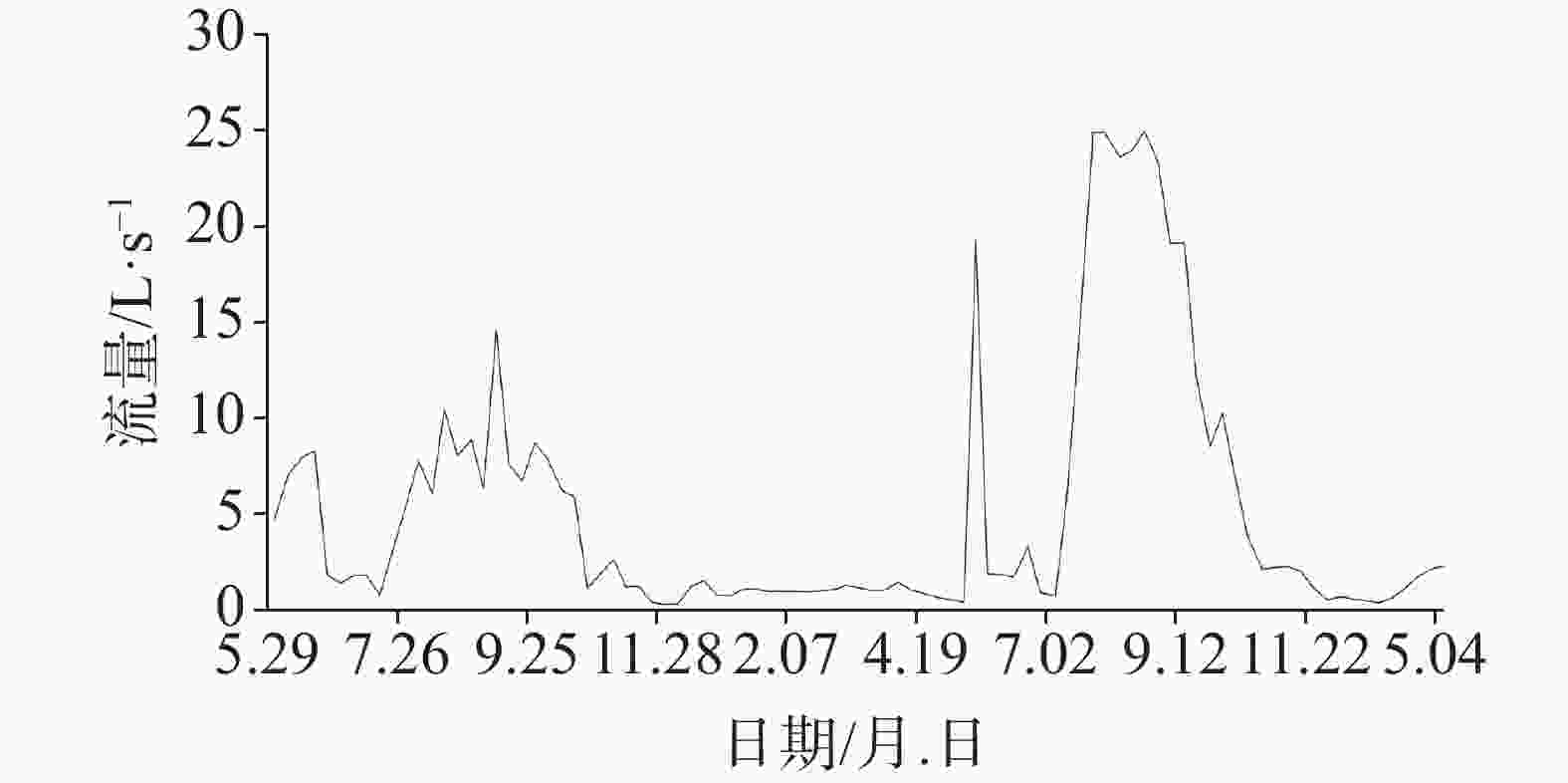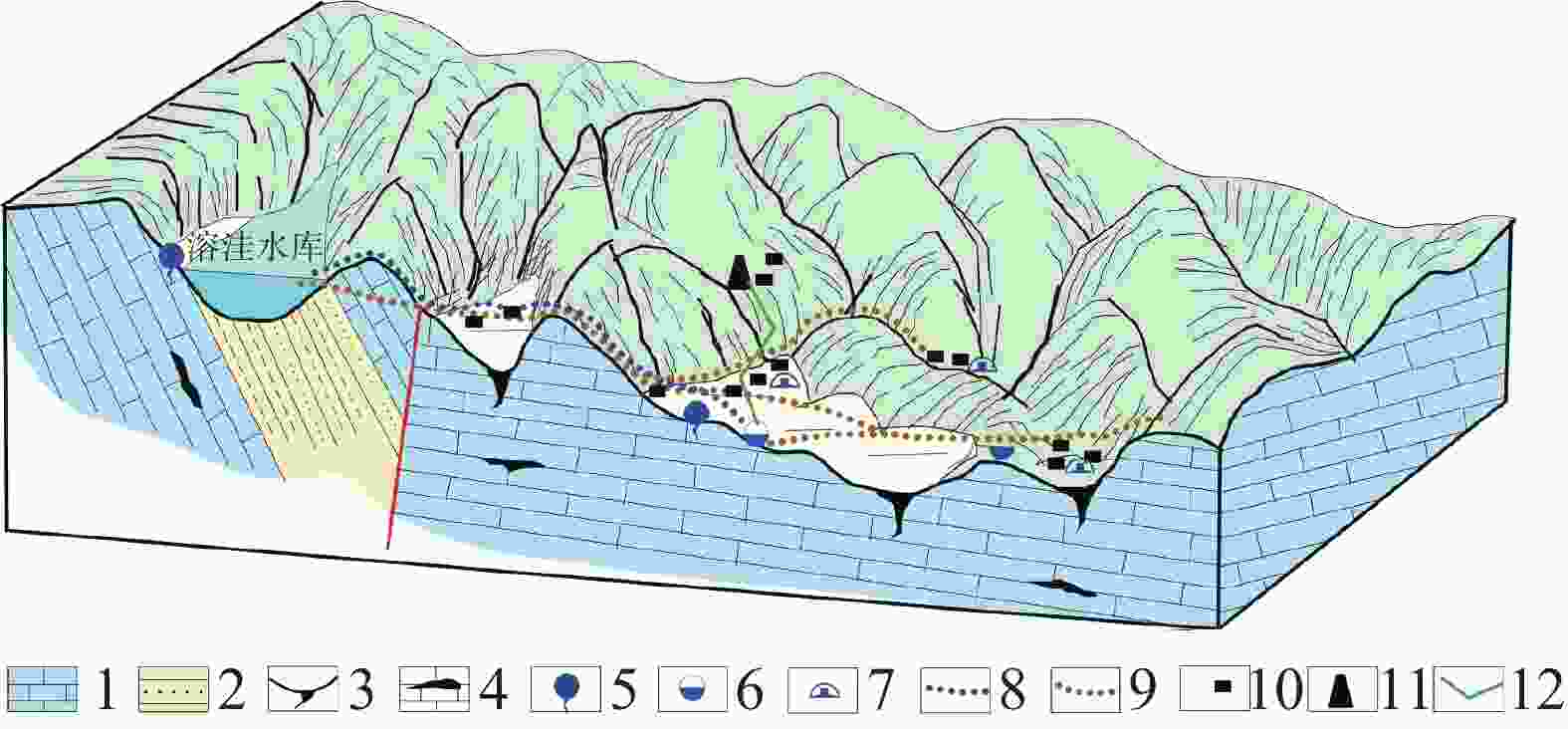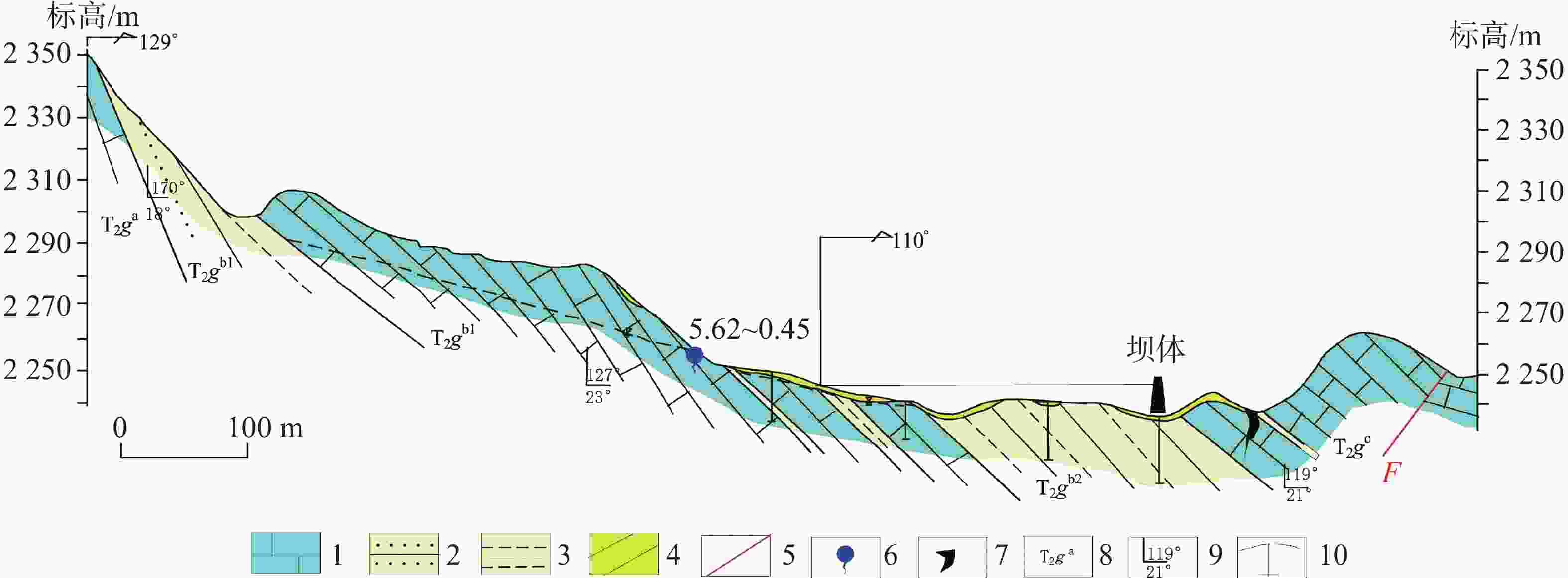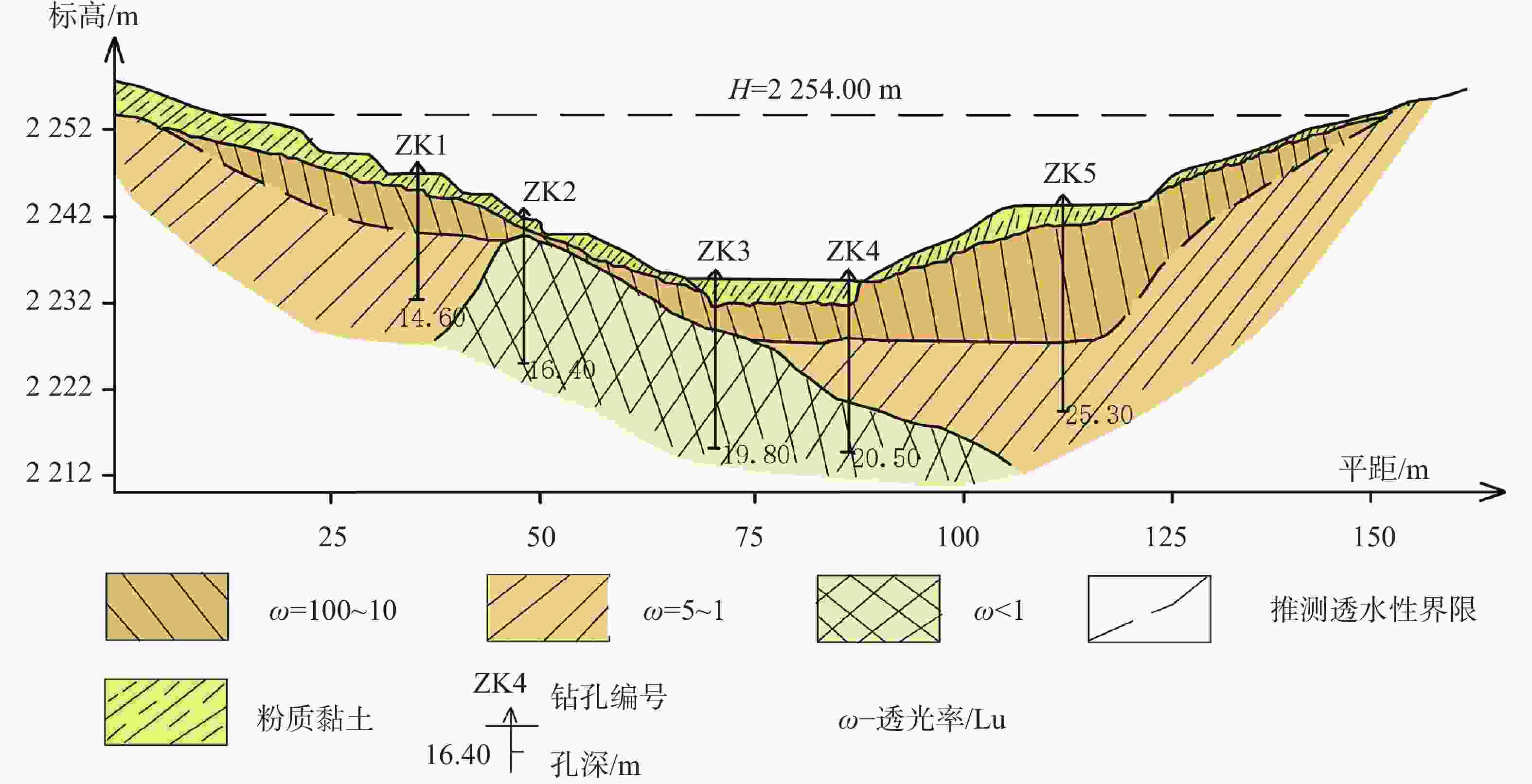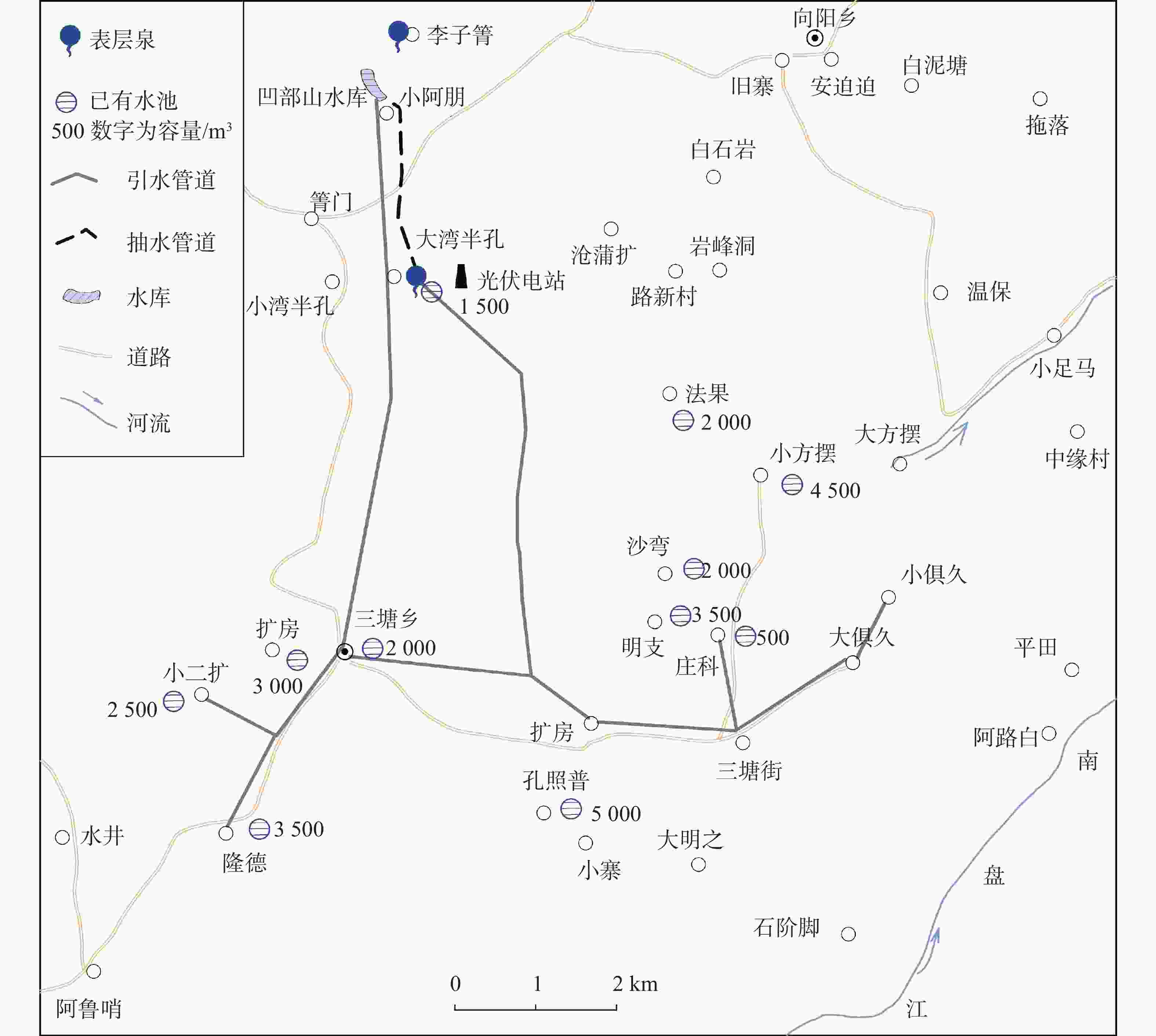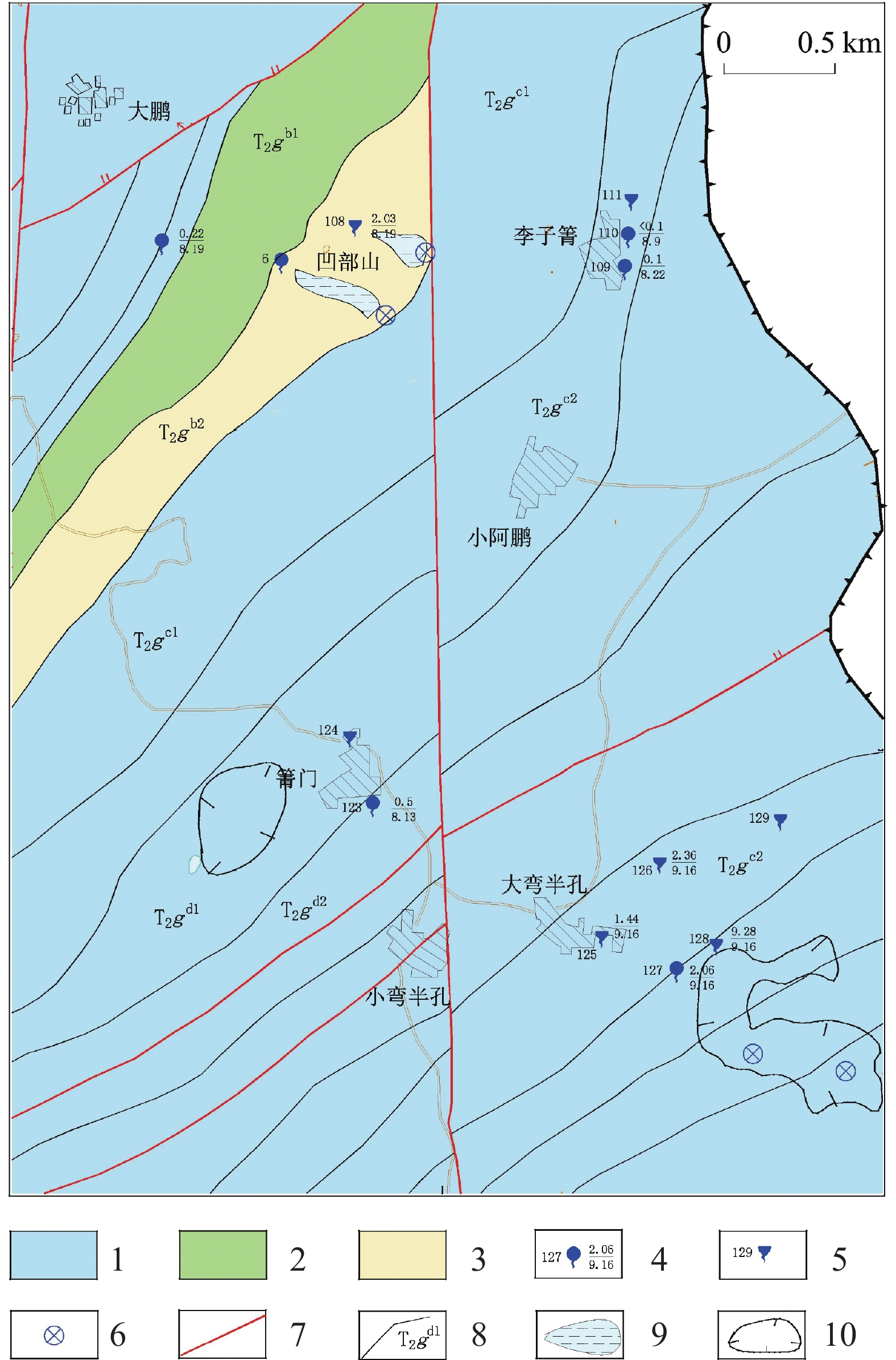Green energy and its high-efficiency utilization model of surface karst springs in karst plateau mountainous area
-
摘要: 为解决岩溶高原山区缺水的问题,合理开发利用表层岩溶水,开展了水文地质详细调查。查明区内表层岩溶泉出露13个,流量0~67.53 L·s−1,动态变化与降水关系密切。文章总结了表层岩溶水“泉-池(窖)-库”优化调控、绿能高效开发利用模式:①在有砂泥岩夹层分布的凹部山岩溶洼地,采用防渗帷幕灌浆,建设悬挂式凹部山水库,积蓄地表水、表层岩溶水形成自流供水;②在湾半孔表层泉处建设蓄水池直接引流利用;③在湾半孔表层泉附近建设水泵站、光伏电站,平水期时通过光伏电站发电,由泵站自动控制抽取表层岩溶水补给凹部山水库,形成地表、地下水优化调控,联合调度调蓄利用25.3万m3·a−1,解决了区内13 000余人的生活生产用水困难问题。Abstract: To solve the problem of water shortage in karst plateau mountainous area, this study on the model of development and utilization of surface karst water is conducted. The karst mountainous area in east border of Luxi basin isa typical cluster-peak depression region with an average altitude from 2,100-2,300 m. Depressions and sinkholes are developed there. Outcrops in this area are mailnly composed of limestone and dolomite in sections a, c, d and e of Gejiu formation (T2g), and partially composed of T2g b mudstone, calcareous mudstone, stacked siltstone with marlstone and limestone. The area is generally a monoclinal structure. Detailed hydrogeology research shows that there are 13 exposed epikarst springs with the flow of 0-67.53 L·s−1 due to precipitation. The water leakage in this area is fast, and drought and water shortage are very severe. Thus, surface karst water becomes a very valuable natural resource. This article summarizes a green, high-efficient method of development and utilization of surface karst water as "spring-pool(cellar)-reservoir" optimal management model. In karst concave depression area with siltstone, the grouting with anti-seepage curtain was conducted at the grouting depth of 1.9-16.3 m. An earth dam was built at an anti-seepage foundation and a reservoir with a total storage of 140,000 m3 was constructed to reserve surface water and surface karst water to supply the downstream villages. Below the nozzles of epikarst springs with large flows in Wanbankong depression area, two 1,500-square-meter storage ponds were built to connect the current water supply network for downstream villages. This model of development and utilization of surface karst water is called "spring-pond-cellar" linkage model with an exploitation quantity of around 73,000 m3·a−1. The distance between Aobushan Reservoir and Wanbankong epikarst spring is around 4 km and the reservoir is around 100 m higher than the Wanbankong spring. The flow of the Wanbankong epikarst spring is quite big but very unstable and cannot be reserved. Most of the water in rain season (around 493,700 m3·a−1 accounting for 81.4% of the annual volume) enters to the underground through sinkhole and cannot be utilized. To make the most of reservoir regulation function from surface karst water against rainfall, a pump station and a photovoltaic power plant have been bulit near the Wanbankong epikarst spring. In the rainy season-water stable period with large flows, electric power is generated from the photovoltaic power plant and the pump station will draw surface karst water (around 40,000 m3·a−1) to the upstream Aobushan reservoir. Thus, the reservoir capacity increases from 140,000 m3 to 180,000 m3 under the condition that the reservoir cannot be expanded. In this case, the water supply capacity will increase in dry season. The surface water and underground water are regulated optimally and the total volume of surface spring water and surface water is up to 253,000 m3·a−1. This model may solve the problem of over 13,000 people’s domestic and production water demand, as well as the water demand from seedling over 10,000 Mu in the dry season.
-
Key words:
- fault basin /
- karst area /
- surface karst water /
- utilization model /
- karst spring /
- Luxi in Yunnan
-
表 1 湾半孔表层岩溶泉流量动态特征表(2004年)
Table 1. Dynamic characteristics of discharge of discharge of surface karst springs in Wanbankong(2004)
编号 最小流量/L·s−1 最大流量/L·s−1 动态系数 箐门124 0 3.06 会断流 湾半孔125 0 30 断流但不干涸 湾半孔126 0 20 会断流 湾半孔127 0.4 24.86 62.2 湾半孔128 0 67.53 会断流 凹部山6 0.45 5.62 12.5 李子箐110 0.04 0.11 2.8 李子箐111 0 2 会断流 李子箐109 0.2 10 50 -
[1] 王宇, 张贵, 李丽辉, 等. 岩溶找水与开发技术研究[M]. 北京: 地质出版社, 2007.WANG Yu, ZHANG Gui, LI Lihui. Study on karst water exploration and development technology[M] . Beijing: Geological Publishing House, 2007. [2] 夏日元, 等. 西南岩溶石山区地下水资源调查评价与开发利用模式[M]. 北京: 科学出版社, 2018.XIA Riyuan, et al. Investigation and evaluation of groundwater resources and development and utilization mode in karst rocky mountainous areas of Southwest China [M]. Beijing: Science Press, 2018. [3] 张华, 王波, 王宇, 张贵, 何绕生, 代旭升, 康晓波, 蓝芙宁. 云南泸西岩溶断陷盆地水循环系统及水资源循环利用方案[J]. 地球学报, 2021, 42(3):313-323. doi: 10.3975/cagsb.2020.090603ZHANG Hua, WANG Bo, WANG Yu, ZHANG Gui, HE Raosheng, DAI Xusheng, KANG Xiaobo, LAN Funing. The water circulation system and water resources recycling plan of the Luxi karst fault-depression basin in yunnan[J]. Acta Geoscientica Sinica, 2021, 42(3):313-323. doi: 10.3975/cagsb.2020.090603 [4] 张贵, 周翠琼, 王波, 顾维芳, 戴文敏, 张文鋆. 滇东南岩溶区找水打井经验: 以云南省广南县珠琳地区为例[J]. 中国岩溶, 2017, 36(5):626-632.ZHANG Gui, ZHOU Cuiqiong, WANG Bo, GU Weifang, DAI Wenmin, ZHANG Wenjun. Experiences of well drilling for water search in karst areas of southeastern Yunnan Province: An example of the Zhulin area, Guangnan county[J]. Carsologica Sinica, 2017, 36(5):626-632. [5] 蒋忠诚, 王瑞江, 裴建国, 何师意. 我国南方表层岩溶带及其对岩溶水的调蓄功能[J]. 中国岩溶, 2001, 20(2):106-110. doi: 10.3969/j.issn.1001-4810.2001.02.005JIANG Zhongcheng, WANG Ruijiang, PEI Jianguo, HE Shiyi. Epikarst zone in South China and its regulation function to karst water[J]. Carsologica Sinica, 2001, 20(2):106-110. doi: 10.3969/j.issn.1001-4810.2001.02.005 [6] 劳文科, 李兆林, 罗伟权, 梁彬. 洛塔地区表层岩溶带基本特征及其类型划分[J]. 中国岩溶, 2002, 21(1):30-35. doi: 10.3969/j.issn.1001-4810.2002.01.007LAO Wenke, LI Zhaolin, LUO Weiquan, LIANG Bin. Main features and classification of epikarst in Luota area[J]. Carsologica Sinica, 2002, 21(1):30-35. doi: 10.3969/j.issn.1001-4810.2002.01.007 [7] 夏日元, 陈宏峰, 邹胜章, 等. 表层岩溶带研究方法及其意义[A]//中国岩溶地下水与石漠化研究[C]. 南宁: 广西科学技术出版社, 2003, 141-147.XIA Riyuan, CHEN Hongfeng, ZOU Shengzhang, et al. Study method of surface karst zone and its significance [A]// Study on karst groundwater and rocky desertification in China [C]. Nanning: Guangxi Science and Technology Press, 2003, 141-147. [8] 章程, 袁道先, 曹建华, 蒋忠诚. 典型表层岩溶泉短时间尺度动态变化规律研究[J]. 地球学报, 2004, 25(4):467-471. doi: 10.3321/j.issn:1006-3021.2004.04.013ZHANG Cheng, YUAN Daoxian, CAO Jianhua, JIANG Zhongcheng. An analysis of short-term scale variation of the typical epikarst spring[J]. Acta Geoscientica Sinica, 2004, 25(4):467-471. doi: 10.3321/j.issn:1006-3021.2004.04.013 [9] 覃小群, 蒋忠诚. 表层岩溶带及其水循环的研究进展与发展方向[J]. 中国岩溶, 2005, 24(3):250-254. doi: 10.3969/j.issn.1001-4810.2005.03.015QIN Xiaoqun, JIANG Zhongcheng. A review on recent advances and perspective in epikarst water study[J]. Carsologica Sinica, 2005, 24(3):250-254. doi: 10.3969/j.issn.1001-4810.2005.03.015 [10] 王宇. 西南地区岩溶水源地类型及开发技术条件[J]. 中国岩溶, 2009, 28(4):370-374. doi: 10.3969/j.issn.1001-4810.2009.04.006WANG Yu. Classification and exploitive technical condition of karst water source field in Southwest China[J]. Carsologica Sinica, 2009, 28(4):370-374. doi: 10.3969/j.issn.1001-4810.2009.04.006 [11] 王宇. 云南省岩溶水开发利用条件分析评价[J]. 水利学报, 2001(1):49-52. doi: 10.3321/j.issn:0559-9350.2001.01.009WANG Yu. Study on explotation and utilization condition of karst groundwater in Yunnan Province[J]. Journal of Hydraulic Engineering, 2001(1):49-52. doi: 10.3321/j.issn:0559-9350.2001.01.009 [12] 劳文科, 祁晓凡, 刘慧敏, 蒋忠诚, 覃小群, 覃星铭. 广西果化龙何地区表层带岩溶水系统及其水资源特征[J]. 中国岩溶, 2008, 27(2):122-128. doi: 10.3969/j.issn.1001-4810.2008.02.005LAO Wenke, QI Xiaofan, LIU Huimin, JIANG Zhongcheng, QIN Xiaoqun, QIN Xingming. Characters of epikarst water system and water resources in Longhe, Guohua, Guangxi[J]. Carsologica Sinica, 2008, 27(2):122-128. doi: 10.3969/j.issn.1001-4810.2008.02.005 [13] 洛塔岩溶地质研究组. 洛塔岩溶及其水资源评价与利用的研究[M]. 北京: 地质出版社, 1984.Luota Karst Geology Research Group. Luota karst and its water resources evaluation and utilization research [M]. Beijing: Geological Publishing House, 1984. [14] 王腊春, 史运良. 西南喀斯特峰丛山区雨水资源有效利用[J]. 贵州科学,2006, 24(1): 8-13.WANG Lachun, SHI Yunliang. The availability of rainwater resources at karst mountains in Southwest China[J]. Guizhou Science, 2006, 24(1): 8-13. [15] 朱海彬, 任晓冬, 李开忠. 贵州喀斯特地区表层岩溶带水资源开发利用研究[J]. 中国农村水利水电, 2015 (1): 60-63.ZHU Haibin, REN Xiaodong, LI Kaizhong. The development and utilization of water resources in the epikarst zone of karst areas in Guizhou[J]. China Rural Water and Hydropower, 2015 (1): 60-63. [16] 姜光辉, 郭芳. 表层岩溶泉的水资源管理与开发工程设计[J]. 水文, 2008, 28(4):31-33. doi: 10.3969/j.issn.1000-0852.2008.04.009JIANG Guanghui, GUO Fang. Water resources management and exploitation design of epikarst spring[J]. Journal of China Hydrology, 2008, 28(4):31-33. doi: 10.3969/j.issn.1000-0852.2008.04.009 [17] 贺卫, 李坡, 吴克华. 花江峡谷示范区表层岩溶水资源的开发与保护[J]. 水资源保护, 2011, 27(2):13-17. doi: 10.3969/j.issn.1004-6933.2011.02.004HE Wei, LI Po, WU Kehua. Epikarst water resources development and protection in Huajiang Gorge exemplary area[J]. Water Resources Protection, 2011, 27(2):13-17. doi: 10.3969/j.issn.1004-6933.2011.02.004 [18] 任蕊, 杨成程, 匡野. 乌蒙山岩溶缺水地区表层岩溶泉有效开发模式研究[J]. 地下水. 2018, 40(2): 24-26.REN Rui, YANG Chengcheng, KUANG Ye. Study on the exploitation model of epikarst spring karst water Wumengshan area[J]. Ground water, 2018, 40(2): 24-26. [19] 彭淑惠, 李继红. 滇东岩溶区表层岩溶水源地特征及其开发利用[J]. 云南地质,2006, 25(2): 249-255.PENG Shuhui, LI Jihong. The characteristics & developmen of epigenic karstwater in East Yunnan[J]. Yunnan Geology, 2006, 25(2): 249-255. [20] 王宇, 张贵. 泸西小江流域水文地质特征及岩溶水有效开发利用[A]//中国岩溶地下水与石漠化研究[C]. 南宁: 广西科学技术出版社, 2003,189-196.WANG Yu, ZHANG Gui. Hydrogeological characteristics and effective Development and utilization of karst water in Luxi Xiaojiang basin [A]//Study on Karst groundwater and Rocky desertification in China [C]. Nanning: Guangxi Science and Technology Press, 2003:189-196. [21] 云南省地质调查院. 泸西小江流域岩溶水调查开发与石漠化综合治理示范[R]. 昆明: 云南省地质环境监测院, 2005.Yunnan Institute of Geo-Environment Monitoring. Investigation and development of karst water and comprehensive control demonstration of rocky desertification in Luxi Xiaojiang Watershed[R]. Kunming: Yunnan Institute of Geo-Environment Monitoring, 2005. -




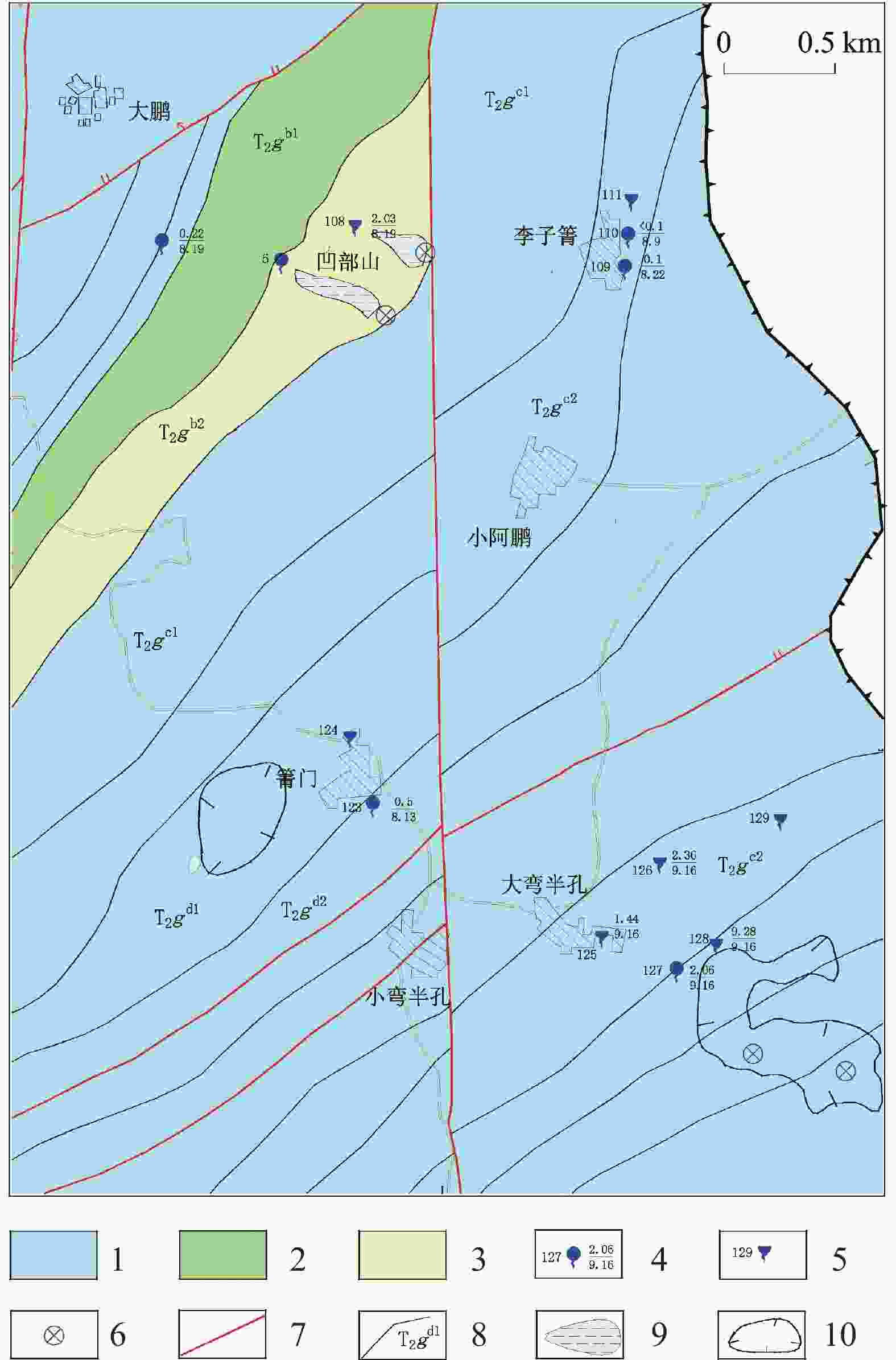
 下载:
下载:
